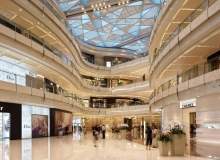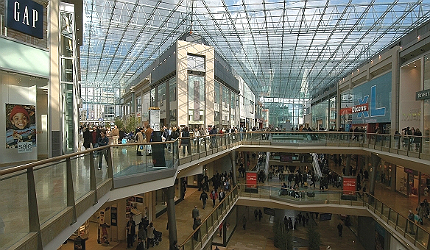

Innovations in Retail Design, Enhancing Shopping Centre Experiences
Ever since the idea of the large-scale shopping mall, an enclosed retail space that could claim to offer all things to all people, started to take off in the US in the 1950s, they have found a comfortable spot squarely at the centre of western consumer culture. These colossi of commerce have become the physical embodiment of the capitalist ideal: all the goods you could ever hope to buy, collected and categorised under one roof.
Shopping centres have also come to represent the irresistible forward momentum of this consumer system, and its export from the US and Europe to all corners of the world. Where countries in East Asia and the Middle East might have balked at the introduction of western-style malls in the past, cities such as Beijing, Dubai and Manila now host some of the largest examples of these developments in the world.
Despite (or perhaps because of) their ubiquity, shopping centres have traditionally been derided for their unimaginative, cookie-cutter design and artificial atmosphere. These soulless structures, critics argue, cut the heart out of our once lively high streets in favour of a shopping experience for which the only advantage is sheer excess.
In the last 15 years, however, the reputation of large-scale shopping malls has undergone a slow but steady rehabilitation, at least in design circles. The consensus view that malls are airless and claustrophobic has been progressively undermined by new projects that have been introducing design innovation and subtle individuality to the traditional shopping centre template, especially when viewed from the inside.
Open for business: the new generation of malls
As the design team behind some of the largest and most memorable of this new crop of shopping centres, international architecture firm Benoy has had a first-hand view of the changes occurring in the world of indoor retail. Benoy’s UK director David Ellis has been designing retail-led schemes since 1995 and has played a part in the design and planning of several of the world’s most famous shopping centres, from Bluewater and Westfield London in the UK to the Elements mall in Hong Kong and the Shanghai IFC shopping centre on the Chinese mainland.
Bluewater, the massive regional shopping centre completed in Kent in 1999, represents a turning point in shopping centre design, says Ellis. “It was the first of the new generation of malls, if you like. It took a building typology that was rather tired, that perhaps people thought had run its course, and turned that on its head. It put a level of customer experience and customer satisfaction as its number one priority. Everything you’ve seen since that point really stems from the work that we did at Bluewater. It was quite a seminal scheme at the time. In fact, we still take overseas clients to see Bluewater, because they recognise that there are still some lessons to be learnt from it.”
The great indoors: bringing the outside in
A key factor in the success of these new shopping centres is a strong reaction against the closed-off, somewhat drab interior spaces of traditional malls. New projects aim to banish all thoughts of dull, artificially lit halls with the introduction of massive glass roofs and facades, offering a more seamless connection between the indoor shopping space and the world outside.
Current shopping centre projects are focused on creating a fresh indoor atmosphere, either using glass to allow plenty of natural light into the space, or even melding the concepts of internal and external with schemes that flow effortlessly from inside to outside. “If you look at Liverpool One, it’s a completely external scheme; it’s got all those levels of customer service that I mentioned with Bluewater, but it’s completely external,” says Ellis. “The Bullring [a retail scheme in Birmingham, UK] is a combination of both external high street and internal mall. So I think it’s very easy to achieve, and it’s really important.”
Ellis believes that this middle ground between indoor and outdoor shopping is going to be a vital trend in the next few years. “[Shopping centres] are going to have to make sure that they’re seamlessly integrated with town and city centres,” he says. “They may be open extensions to high streets, where the start and end of the shopping centre can’t really be determined – achieving that seamlessness of progression with the high street. There will possibly be a trend for external spaces that are covered, and we’ve seen that in places like Liverpool One, and I think we’ll see that developing even further, where developers don’t necessarily want to build internalised spaces, but they want to give degrees of shelter.”
Retail interior design – balancing beauty and business
New ideas on retail interior design have also had an influence on the look that modern shopping centres are striving for. The modern mall interior is a picture frame, a platform on which retailers can successfully trade. As such, the interior trend for shopping centres now leans towards clean, cool designs that allow the shops themselves to be the centre of attention. It’s a step away from the baroque extravagance of schemes such as the Trafford Centre in Manchester (dubbed “the people’s palace” by its developer) and towards the neutral elegance of Westfield London and its ilk.
This move might be a shame for those who like their shopping experiences a little more eclectic, but Ellis says a tranquil design is helpful for both retailers and customers. “We’re trying to create interiors which are a little bit calmer, visually a bit less ‘designed’. We still want to introduce warmth; we don’t want it to be sterile. It shouldn’t be a sea of white. So we’re introducing warmth and material and texture and colour, but it’s done in a way that’s quite restrained, to allow the retailer, the shop-front to shine.
“We might then start to create areas of activity and visual interest, where we’re creating food and beverage outlets or areas for rest, for people to take five minutes away from the hurly-burly of the shopping. We might introduce those almost as an accent colour in an interior design scheme.”
Unobtrusive design and areas dedicated to rest are also important to avoid the feeling of being cooped up that has been so common in shopping centres over the years. “There’s a danger that you might overplan your retail scheme, so that the customers feel as if they’re a gerbil in a wheel, running round and round, never able get off,” Ellis warns.
The visual ambition of a shopping centre scheme’s interior designers might be curbed somewhat by practical retail considerations, but there’s still a delicate balance to be struck between pragmatism and innovation. Ellis holds up Benoy’s work on the Elements retail centre in Hong Kong as an example of visual style being integrated with the project’s brand. The scheme’s branding centres around the five elements of Chinese tradition; as Benoy was involved in all levels of branding and graphic design for the project, this identity could be conveyed with attractive visual elements.
“There were a series of sculptures that were graphic derivations from the brand logo itself, done in a very stylised way,” says Ellis. “They helped to add that level of visual interest inside the scheme. But it is a fine balance; too much and you’re taking away from the retailers. Too little, and you risk it being too bland, too anodyne in what it looks like.”
Shopping centres of the future
The scale and spectacle of modern retail schemes, with their flowing paths between inside and outside, gives an indication of the main challenge facing shopping centres in the digital age: online shopping. “The next ten or 20 years will be finding the right balance between shopping over the internet and shopping in towns and cities,” says Ellis.
“The one thing that towns and cities can give that the internet can’t, is experience. So how do you make that shopping experience exponentially more than you might get just by sitting in front of your laptop? That’s going to be the real challenge because unless we do that, people are not going to be drawn into town centres.”
Cutting-edge shopping centres are trying to achieve this sense of the exclusive experience not only with good design, but also by designing spaces that can offer more than just rows of shops. Restaurant and entertainment options are becoming ever more important. Westfield London has made a name for itself by hosting film premieres and concerts, while Bluewater recently completed a two-storey event and exhibition venue called Glow. All of these developments serve to extend customer dwell time and keep trade brisk.
In city centres, shopping malls might have trumped the humble high street, but the convenience of shopping online will continue to be a cheap, rapidly multiplying alternative to these high-investment, high-stake structures. If the concept of city centre retail is to survive at all, it is up to shopping centres, in the way that they are designed and the facilities they offer, to provide a compelling enough reason for shoppers to log off and head into town.



